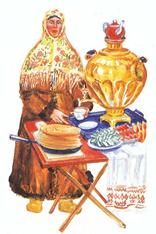1. It was devoted to the rebirth of the sun after the winter solster when the sun turned towards warmth, spring and summer. The festival was celebrated with lavish feasts for everyone, carol singning, and merry games of mummers. Mummers would confuse the evil spirits, drive away wasting diseases and protect people's health. In their incredible masks they frightened evil spirits which trembled all over because of their games.
 2. It was one of the most well-loved holidays of the year. The celebrations involved everybody, both young and old. It was believed in ancient times that the magic flower of a fern blossomed on that night. It was called a fire flower. Anyone who wanted to pick it on this night was supposed to do so with a clean conscience and pure thoughts. The fern was guarded by hordes of witches and evil spirits. It was believed that whoever picked the flower of a fern would have power over the dark forces and be able to see treasures hidden in the ground, understand the language of grass, animals, birds, and winds.
2. It was one of the most well-loved holidays of the year. The celebrations involved everybody, both young and old. It was believed in ancient times that the magic flower of a fern blossomed on that night. It was called a fire flower. Anyone who wanted to pick it on this night was supposed to do so with a clean conscience and pure thoughts. The fern was guarded by hordes of witches and evil spirits. It was believed that whoever picked the flower of a fern would have power over the dark forces and be able to see treasures hidden in the ground, understand the language of grass, animals, birds, and winds.
 3. It was the jolliest and the most ancient of all. The Slavs devoted it to Yarilo, the god of the sun and fertility.The Slavs believed that the
3. It was the jolliest and the most ancient of all. The Slavs devoted it to Yarilo, the god of the sun and fertility.The Slavs believed that the  change of seasons was the struggle between Yarilo the Sun and the evil spirits of cold and darkness. The god would die in the battle against the cold in winter but would return to life in spring. The whole week was filled with festive rituals, fun and games. It was a custom to greet the spring with the universal joy — it would help to have a good harvest. People built a straw effigy and put a loose summer dress and a kerchief on it. On the last day of the festival the effigy would be burnt.
change of seasons was the struggle between Yarilo the Sun and the evil spirits of cold and darkness. The god would die in the battle against the cold in winter but would return to life in spring. The whole week was filled with festive rituals, fun and games. It was a custom to greet the spring with the universal joy — it would help to have a good harvest. People built a straw effigy and put a loose summer dress and a kerchief on it. On the last day of the festival the effigy would be burnt.
4. It was linked with care for the boundless strength of the earth and the blossoming fields, meadows and woods. A seven-year old girs would be dressed in festive attire, with ribbons in her plait, and she would have to run around the field three times following the path of the sun. At this point farmers would spread towels on the edge of the field, put out the food they had brought and have a meal together.
Why were there four major pagan holidays?

 2. It was one of the most well-loved holidays of the year. The celebrations involved everybody, both young and old. It was believed in ancient times that the magic flower of a fern blossomed on that night. It was called a fire flower. Anyone who wanted to pick it on this night was supposed to do so with a clean conscience and pure thoughts. The fern was guarded by hordes of witches and evil spirits. It was believed that whoever picked the flower of a fern would have power over the dark forces and be able to see treasures hidden in the ground, understand the language of grass, animals, birds, and winds.
2. It was one of the most well-loved holidays of the year. The celebrations involved everybody, both young and old. It was believed in ancient times that the magic flower of a fern blossomed on that night. It was called a fire flower. Anyone who wanted to pick it on this night was supposed to do so with a clean conscience and pure thoughts. The fern was guarded by hordes of witches and evil spirits. It was believed that whoever picked the flower of a fern would have power over the dark forces and be able to see treasures hidden in the ground, understand the language of grass, animals, birds, and winds. 3. It was the jolliest and the most ancient of all. The Slavs devoted it to Yarilo, the god of the sun and fertility.The Slavs believed that the
3. It was the jolliest and the most ancient of all. The Slavs devoted it to Yarilo, the god of the sun and fertility.The Slavs believed that the  change of seasons was the struggle between Yarilo the Sun and the evil spirits of cold and darkness. The god would die in the battle against the cold in winter but would return to life in spring. The whole week was filled with festive rituals, fun and games. It was a custom to greet the spring with the universal joy — it would help to have a good harvest. People built a straw effigy and put a loose summer dress and a kerchief on it. On the last day of the festival the effigy would be burnt.
change of seasons was the struggle between Yarilo the Sun and the evil spirits of cold and darkness. The god would die in the battle against the cold in winter but would return to life in spring. The whole week was filled with festive rituals, fun and games. It was a custom to greet the spring with the universal joy — it would help to have a good harvest. People built a straw effigy and put a loose summer dress and a kerchief on it. On the last day of the festival the effigy would be burnt.


